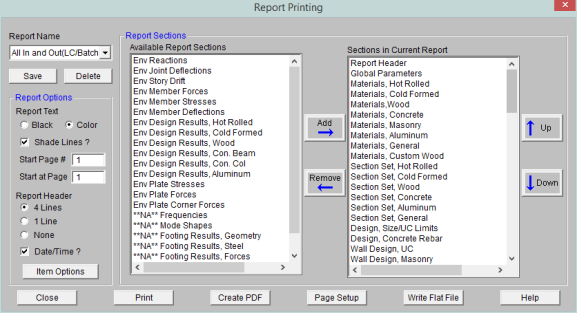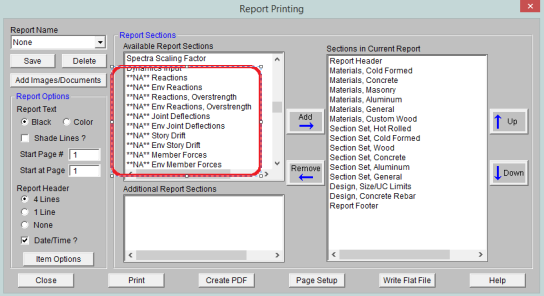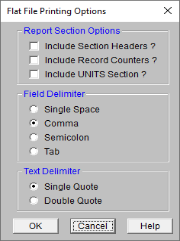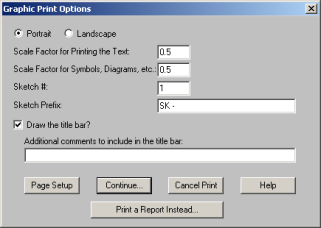 button the following options are presented.
If a model view is currently active, and you select the print button,
Graphic
Print Options are presented.
button the following options are presented.
If a model view is currently active, and you select the print button,
Graphic
Print Options are presented.You may print graphics as they appear on the screen or print all (or
part) of the tabulated model information. If a spreadsheet is currently active
and you click the print  button the following options are presented.
If a model view is currently active, and you select the print button,
Graphic
Print Options are presented.
button the following options are presented.
If a model view is currently active, and you select the print button,
Graphic
Print Options are presented.

If you have lines selected in the spreadsheet then you may print only those lines by selecting the first option. If you wish to print the entire spreadsheet you may choose the second option. The last option allows you to print multiple spreadsheets in a custom report that is discussed in the next section. You may combine the last two options with the Exclude feature to hide some data and print only the data you want.
To Print a Report or a Spreadsheet
 button and
choose to print the current spreadsheet, a selected portion of the spreadsheet,
or multiple sections by printing a report. If you are in a model
view the Graphic Print Options are opened so click 'Print a Report Instead'.
button and
choose to print the current spreadsheet, a selected portion of the spreadsheet,
or multiple sections by printing a report. If you are in a model
view the Graphic Print Options are opened so click 'Print a Report Instead'. button
and choose from the options.
button
and choose from the options.Note
 button.
button.

The Report Printing
To build your own custom report you may
The
Note:

Formatting options allow you to specify many options:
Report Text - Allows you to define the text color as black or blue.
Shade Lines? - Allows you to shade every other line to enhance readability.
Start Page # - Allows you select the starting page number. The number shown will be the next page number in the current sequence, but you can override this for occasions where you need to insert your calculation pages into an existing report and you need the page numbering to match.
Start at Page - Allows you to start your numbering at some page other than page one. This can be helpful if you have a title page or table of contents that you don't want to number.
Date/Time? - Allows you to turn off the Date/Time stamp so that this will not appear on your printed reports.
Item Options - Allows you to select
Note:
A flat file is a file without column headings, print formatting, or graphical elements and is useful for importing and parsing into spreadsheets, database tables, or as post processor input data.

There are several options available to make the flat file easier to parse. Note that printing and then looking at a sample output file with all the options selected will make it easier to understand what the options do.
You have an option to include the 'Section Headers' which will print a
text description of each block of data. For example, the
The field delimiter options let you choose what character will be used
to separate each field of data within record. For example, each
coordinate value in the
The text delimiter works like the field delimiter, except that it’s
used to set apart text labels. All text in the flat file will be
enclosed at the beginning and the end by the selected text delimiter character.
This is very useful when trying to read in label strings that contain
embedded spaces. As an example, the
The current flat file options are saved each time the program is closed.
To Print to a Flat File
 button, Choose
Use Report Printing Options and click OK
button, Choose
Use Report Printing Options and click OKMany of the same options that exist in Report Printing are present in Graphic Printing, but some unique options available are Scale Factors and Title Block Info.

You may include the Title Bar to display the Model Title, Designer, Company Name, Date and Time (All of which are defined in your Project Info). You can also
enter a comment that will be included in the Title
You can specify a Sketch # and a Sketch Prefix to label your graphic prints as well.
Once you have everything the way you want it choose Continue. This will bring you to the print settings that are specific to your printer. The choices are different for each printer but generally allow you to choose the printer, orientation, quality and quantity.
The bottom button Print a Report Instead is provided so you can get to the report printing dialog directly from a graphic view.